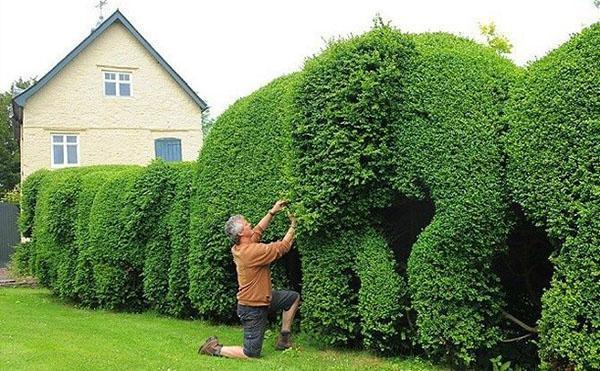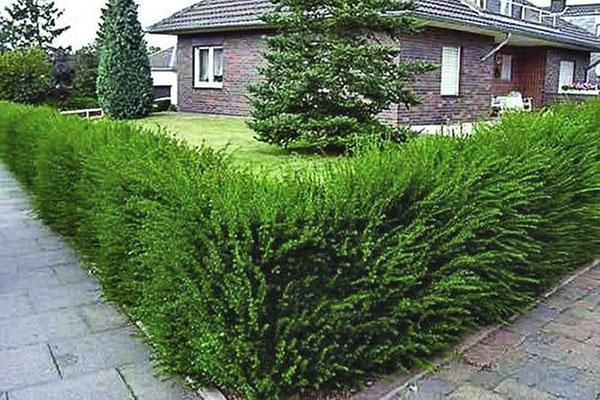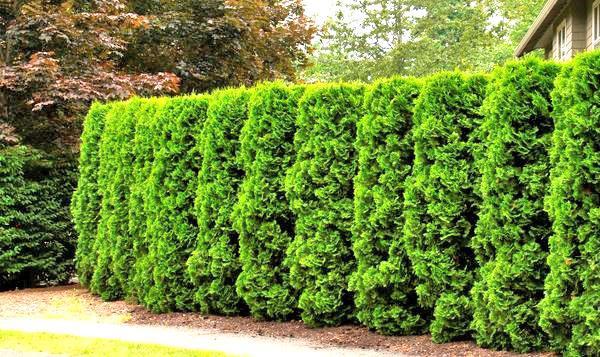Planting a live fence and caring for a hedge
 A living fence is a popular solution in landscape design. Even a novice gardener can create a green hedge of trees or shrubs instead of a regular brick fence. Plants that are selected for this purpose usually tolerate frost, heat and drought well and require minimal maintenance. However, it is worth asking in advance in what conditions the selected trees feel comfortable so that the hedge fence grows tall and lush.
A living fence is a popular solution in landscape design. Even a novice gardener can create a green hedge of trees or shrubs instead of a regular brick fence. Plants that are selected for this purpose usually tolerate frost, heat and drought well and require minimal maintenance. However, it is worth asking in advance in what conditions the selected trees feel comfortable so that the hedge fence grows tall and lush.
To form the correct crown of an unusual shape, it will take a lot of time and skill of the gardener
Tips for creating a plant fence
Landscaping is a big challenge. To make the composition look harmonious, all plants should be carefully selected according to their color and preferences. In addition, trees can be not only beautiful but also functional. For example, a house in an open area can be protected with a living fence made of conifersthat will protect the owner of the site from the cold wind. If the house is used only as a summer cottage, it is enough to plant deciduous trees. They will bloom and delight the eye in spring. To protect against animals, you should pay attention to the prickly varieties (barberry).
The first decision to make is what to plant in the country for a live fence. All such designs can be conditionally divided into several varieties:
- green borders - fences up to 0.5 m in height, which are used not only along the perimeter of the summer cottage, but also to decorate flower beds or paths (boxwood, magnolia, heather);
- hedge - a structure up to 2.5 m, which will protect from the wind and create a shadow near the fence;
- a green wall is a fence higher than 2.5 m, planted for a full-fledged fence of the site.
The owner of a plot with a living fence should learn all the intricacies of tree pruning. If the crown is not formed and neatly trimmed, the hedge will look untidy.
What plants can I use?

A low hedge is used for decorative purposes - it will not protect the area from wind or sun
Decorative thuja fence

Thuja Is an evergreen coniferous tree that is great for creating a hedge. It is planted in the ground or a special brickwork is created, where the seedlings are placed. For cultivation in cold climates, exclusively varieties of western thuja are suitable. Oriental varieties do not tolerate frost, especially at a young age.
 Thuja can be replaced with some types of cypress, but it is more adapted to life in temperate climates. It looks great on fully classic-style areas, or in combination with large cobblestones or red bricks. This tree grows slowly and requires compliance with some care rules:
Thuja can be replaced with some types of cypress, but it is more adapted to life in temperate climates. It looks great on fully classic-style areas, or in combination with large cobblestones or red bricks. This tree grows slowly and requires compliance with some care rules:
- seedlings are placed in a well-lit area, neighboring plants can be placed close enough to each other;
- you will need fertile soil containing peat or humus; you can also periodically feed the thuja with organic fertilizers;
- young seedlings are covered with a light cloth for the winter so that the needles do not fade under the influence of the bright sun and white snow;
- the crown must be trimmed annually so that the trees grow lush.
A living thuja fence requires careful maintenance. Young seedlings do not tolerate bright sunlight, but in shady areas their crown will turn yellow and fall off.
To create a fence of thuja, you should select varieties that are resistant to frost
Wild grape fence
 A live fence in the country can be built from some types maiden grape... Their fruits are inedible, but the vine is used for decorative purposes to create a green hedge. Shoots can wrap around vertical fence walls without leaving gaps between leaves.
A live fence in the country can be built from some types maiden grape... Their fruits are inedible, but the vine is used for decorative purposes to create a green hedge. Shoots can wrap around vertical fence walls without leaving gaps between leaves.
For growing hedges, you can use several varieties of maiden grapes:
- Three-pointed - a tall plant, unpretentious to the planting site and soil composition, but can die at temperatures below -15 degrees.
- Henry is a grape with bright leaves that take on a bright red hue by autumn.
- Five-leafed - grows well in moist soil, resistant to temperature changes.
The vine hedge releases its first leaves in early spring and they last until late fall. The plant is unpretentious in terms of keeping, and without special care, branches can grow up to 3-4 m in the first year. However, at the end of the season it is necessary to harvest the foliage and trim the shoots.
The vine takes root well and quickly grows along the frame, forming a full-fledged fence
Willow flexible fence
 Willow is not only a large tree with falling branches, but also a huge assortment of shrubs. For a living willow fence, choose low varieties with a spreading crown (haruko nishiki, purple, Babylonian or holly willow). These plants are unpretentious to keeping conditions and can withstand significant temperature changes.
Willow is not only a large tree with falling branches, but also a huge assortment of shrubs. For a living willow fence, choose low varieties with a spreading crown (haruko nishiki, purple, Babylonian or holly willow). These plants are unpretentious to keeping conditions and can withstand significant temperature changes.
When choosing willow as a plant for creating a hedge, it is worth remembering its main features:
- in natural conditions, it grows on the banks of reservoirs, therefore, on dry soil, you will need frequent regular watering;
- in areas open to sunlight, the leaves can discolor and fall off;
- willow grows quickly in fertile soils, and it is worth regularly adding organic fertilizers to the soil;
- at a high level of groundwater or close to water bodies, the plant can be watered much less often.
A flexible willow hedge is ideal for rustic plots. To create a full-fledged openwork fence, you will need young seedlings, a frame or rope. As the main trunk grows, neighboring plants are intertwined with each other, fixing with a rope or other structures. The result is a flat hedgerow with a symmetrical pattern, and the trunks of neighboring trees support each other.
So that the willow fence is strong, the stems of neighboring plants are intertwined with each other as they grow
Ornamental shrub hedge
 Ornamental shrubs can also be grown instead of full-grown tall trees. They will look harmoniously from the outside of the fence, as well as around gazebos and recreation areas. Such plants rarely reach a height of more than 1 m, so they cannot protect them from wind or sun.
Ornamental shrubs can also be grown instead of full-grown tall trees. They will look harmoniously from the outside of the fence, as well as around gazebos and recreation areas. Such plants rarely reach a height of more than 1 m, so they cannot protect them from wind or sun.
A live bush fence can look different. For these purposes, you can choose evergreen varieties or those that renew foliage every year. It is worth paying attention to several main varieties of shrubs that are unpretentious to the conditions of detention:
- boxwood - an evergreen bush with small, solid leaves and a dense crown;

- lilac - a large shrub that will delight you with fragrant flowers every spring;
- hawthorn - forms not only beautiful flowers, but also useful berries;
- tamarix is a sprawling bush with many small pink inflorescences.
A living fence made of trees or shrubs will be of exclusively decorative value if its height does not exceed 1.5-2 m. It is recommended to place such a fence on the outside of a conventional fence for safety reasons.
Flower arrangements as a hedge
 A regular concrete or brick fence, as well as a solid metal structure, can also look beautiful and unusual. Decorating a fence with flowers is suitable for summer cottages that become residential only in the warm season. Roses, violets and any other decorative flowers are suitable for decorating a hedge or gate.
A regular concrete or brick fence, as well as a solid metal structure, can also look beautiful and unusual. Decorating a fence with flowers is suitable for summer cottages that become residential only in the warm season. Roses, violets and any other decorative flowers are suitable for decorating a hedge or gate.
A hedge of rose bushes is a creative solution for decorating a site.
There are several ways to arrange flowers on a fence so that they look harmonious and well-groomed:
- hanging pots are the simplest option that is suitable for planting ampelous plants;
- stone fence combined with multi-colored rose bushes;
- mesh fence with fixed flower pots;
- a wicker fence with the addition of flowers or vegetables.
 A hedge instead of a fence is actively used to decorate summer cottages and protect from cold, wind or sun. It is not only functional, but also gives the house a special atmosphere. However, even the most unpretentious plant varieties need constant care. In addition to standard watering and feeding, it is necessary to form a crown of trees or shrubs, otherwise the hedge will not look neat and well-groomed. In addition, plants need to be selected according to color and style, as well as their preferences for soil composition and illumination should be taken into account.
A hedge instead of a fence is actively used to decorate summer cottages and protect from cold, wind or sun. It is not only functional, but also gives the house a special atmosphere. However, even the most unpretentious plant varieties need constant care. In addition to standard watering and feeding, it is necessary to form a crown of trees or shrubs, otherwise the hedge will not look neat and well-groomed. In addition, plants need to be selected according to color and style, as well as their preferences for soil composition and illumination should be taken into account.